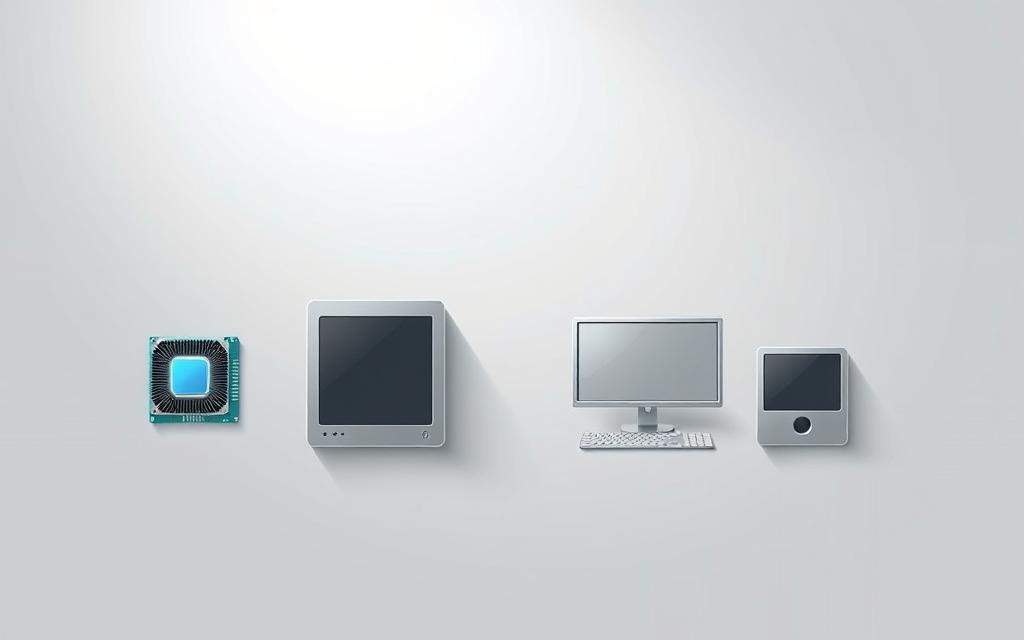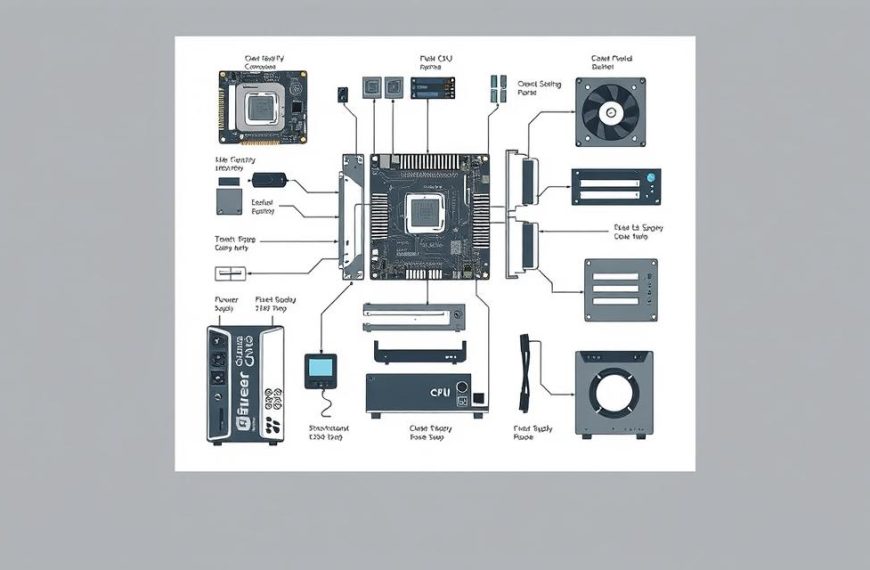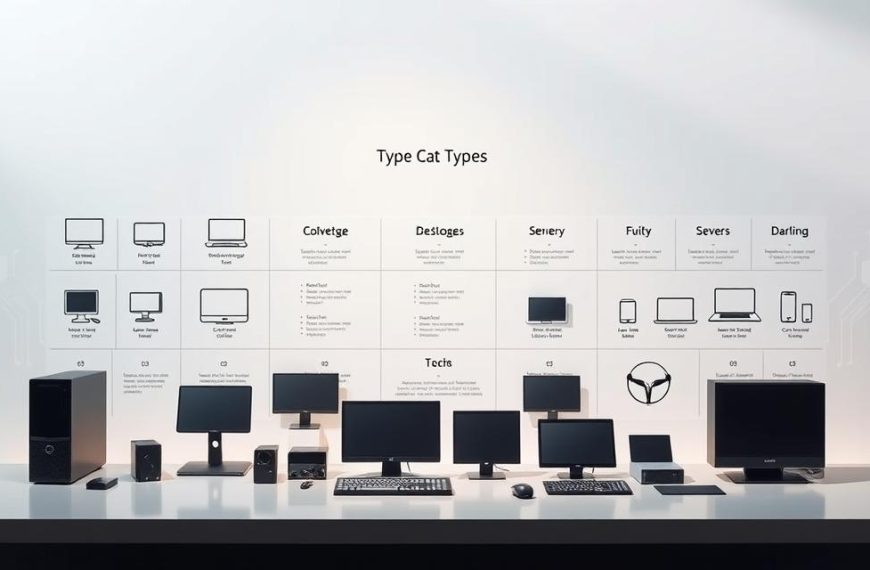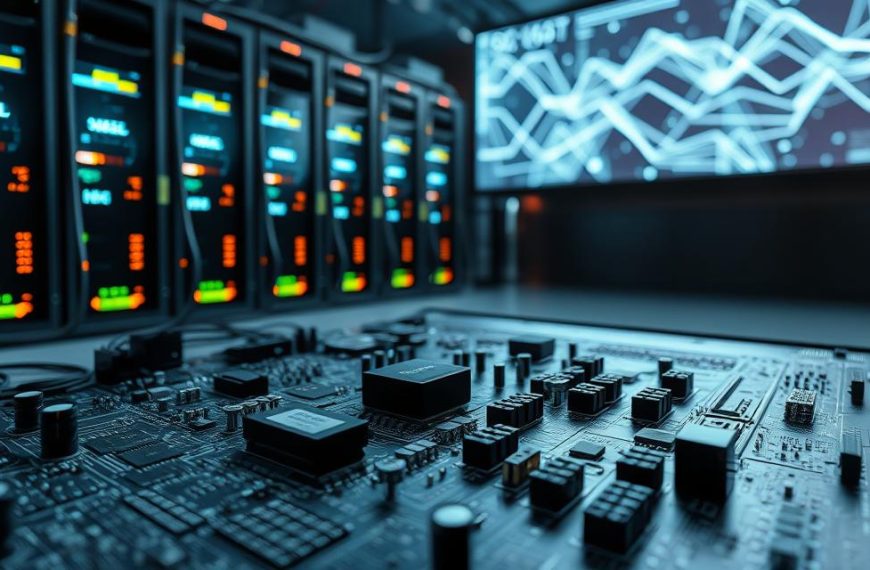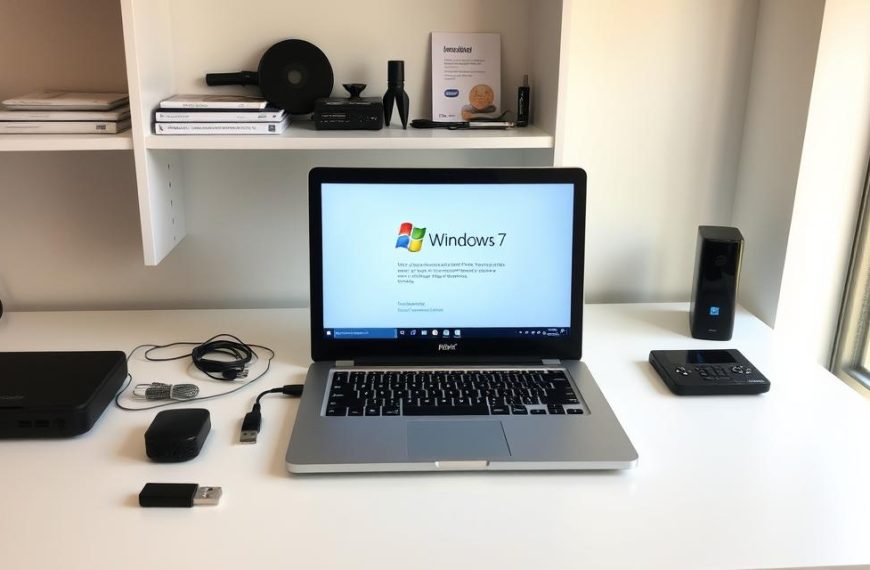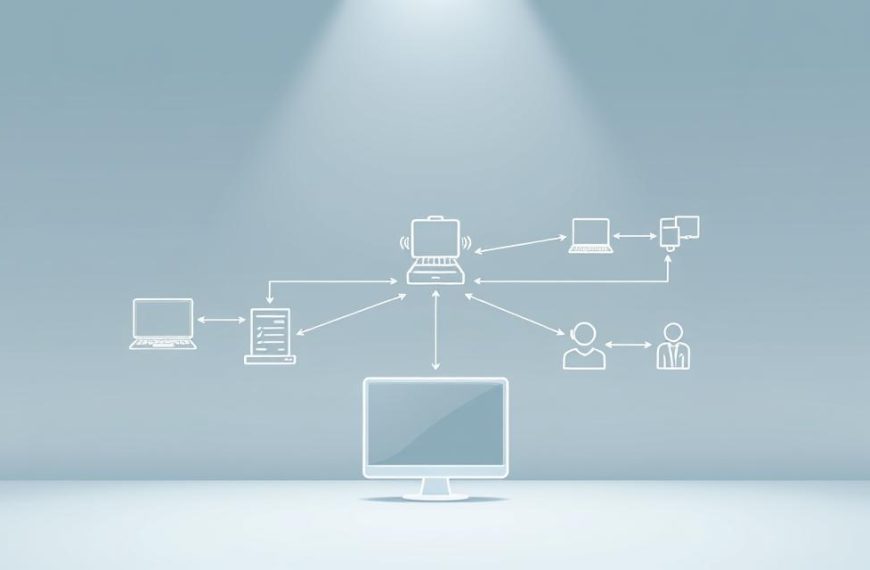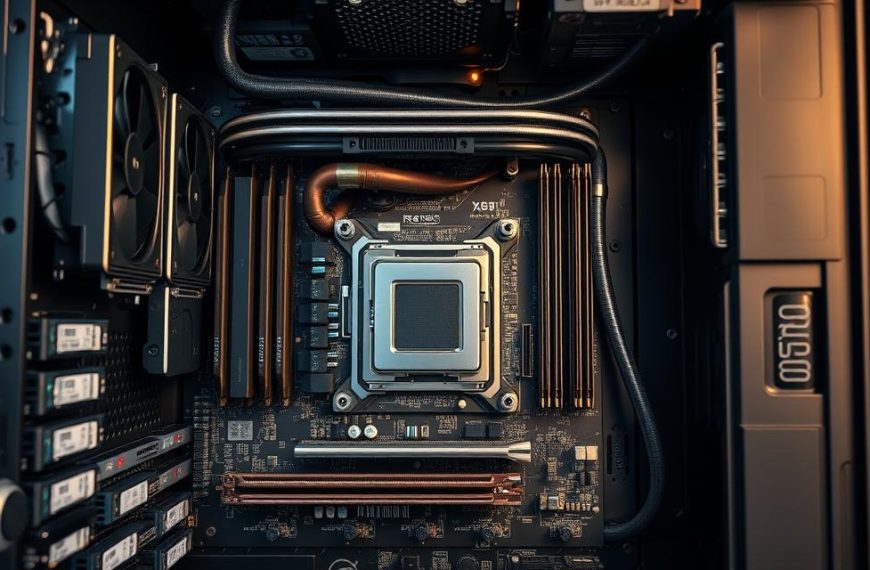Every device, from smartphones to supercomputers, needs core parts to work. These modern computing essentials turn raw data into useful information. Knowing these parts helps us understand how machines work.
Every computer has five key parts. Input devices like keyboards take in commands. Processors then do the math. Memory units hold data temporarily, and output devices like monitors show the results.
The Central Processing Unit (CPU) is the brain, managing tasks between parts.
Learning about computer system components is more than just tech talk. It’s useful for IT pros and everyday users. It also helps exam takers understand hardware fundamentals.
Even old computers like ENIAC had the same basic parts as today’s laptops. This shows why these principles are timeless. Knowing their roles helps us keep up with new tech.
Understanding the Foundations of Modern Computing
Modern computing is built on three key elements: binary logic execution, how components work together, and the way instructions are processed. These basics are the foundation of all digital devices, from phones to huge computers. Let’s look at how these parts come together to make systems work.
The von Neumann architecture is key to designing systems. It divides a computer into four main parts:
- Processing unit (CPU)
- Memory storage
- Input mechanisms
- Output systems
An ATM transaction shows how hardware and software work together:
| Component | Action | Result |
|---|---|---|
| Card Reader | Scans chip | Identifies user |
| CPU | Processes request | Verifies balance |
| Cash Dispenser | Releases notes | Completes withdrawal |
This system architecture runs through clock cycles, measured in gigahertz. Each cycle lets the CPU do its job through the fetch-decode-execute process:
- Retrieve command from memory
- Interpret binary code
- Perform required calculation
Modern advancements add to these computing principles, with multi-core processors doing billions of tasks at once. Knowing this helps us see why upgrading parts can change how well a system works.
What Are the Five Main Components of a Computer System?
Modern computers use different parts to work well. These parts help with processing, storing, and sending data. They make up the core of what a computer can do.
1. Central Processing Unit (CPU)
1.1 Functions and Architectural Design
The CPU is like the brain of the computer. It follows a cycle to do tasks: fetch, decode, execute, and write-back. Intel’s Hybrid Architecture is a new design. It helps computers handle tasks better.
1.2 Processor Types: From Intel Core i9 to AMD Ryzen
AMD’s Ryzen 9 7950X3D uses 3D V-Cache technology for better gaming. Intel’s Thermal Velocity Boost makes high-end models go faster. The main difference is:
- Intel: Better for gaming
- AMD: Great for creating content
2. Memory (RAM)
2.1 Volatile Storage Mechanisms
RAM is where apps run temporarily. It loses data when turned off. New DDR5 modules, like Corsair Dominator Platinum, are 50% faster than DDR4.
2.2 DDR4 vs DDR5: Capacity and Speed Comparisons
| Feature | DDR4 | DDR5 |
|---|---|---|
| Max Module Size | 32GB | 128GB |
| Base Speed | 3200 MT/s | 4800 MT/s |
| Voltage | 1.2V | 1.1V |
3. Storage Solutions
3.1 HDD vs SSD: Performance Trade-offs
Seagate’s IronWolf HDDs hold up to 18TB at a low cost. Samsung’s 990 Pro SSD is fast but more expensive. HDDs are good for storing lots of data, but SSDs are faster.
3.2 Emerging Technologies: NVMe and Cloud Storage
WD Black SN850X drives are very fast, thanks to PCIe 5.0. Cloud storage, like Microsoft Azure Stack, is affordable and scalable.
4. Input/Output Devices
4.1 Peripheral Classification: Keyboards to 4K Monitors
High-refresh monitors, like ASUS ROG Swift PG32UQX, work well with precise keyboards. Important types include:
- Data entry devices (scanners, microphones)
- Output displays (projectors, VR headsets)
4.2 Wireless vs Wired Connectivity Standards
Bluetooth 5.3 keeps connections strong up to 40 metres. USB4 is fast enough for two 4K displays. But, wired devices are best for fast gaming.
5. Motherboard Architecture
5.1 Circuit Board Integration Principles
Modern motherboards, like MSI MEG Z790 Godlike, have lots of ports and fast connections. They support high-power CPUs with 20+1 phase designs.
5.2 Chipset Compatibility: Intel Z790 vs AMD X670
Intel’s Z790 chipsets support DDR5-5600 and PCIe 5.0. AMD’s X670 boards have better USB4 and NVMe. The main difference is:
- Intel: Better memory overclocking
- AMD: Native USB4
System Component Interactions
Modern computing is like an orchestra where each part works together. If one part is slow, the whole system slows down. This section looks at how parts talk to each other and how to fix common problems.
Data Flow Between Hardware Elements
Think about typing in a word processor. The keyboard sends signals to the CPU through the motherboard. The CPU then understands these signals, gets data from RAM, and saves changes.
Source 1’s Notepad example shows how it works. Text you type stays in RAM until you save it. Then, the storage drives write it down for good.
“GPU throttling in gaming PCs often stems from inadequate cooling, reducing clock speeds by up to 40% during intensive tasks.”
Bottleneck Identification and Resolution
System bottlenecks happen when one part slows down the whole system. For example, a fast CPU paired with a slow HDD causes delays. Here’s a look at common bottlenecks:
| Component | Data Throughput | Typical Bottleneck Scenarios |
|---|---|---|
| RAM | Up to 50 GB/s | Insufficient capacity causes frequent HDD/SSD swaps |
| NVMe SSD | 3.5 GB/s | Outperforms SATA III interfaces (600 MB/s) |
| GPU | 448 GB/s (GDDR6X) | Thermal throttling under sustained loads |
Here are some steps to fix problems:
- Keep an eye on CPU/GPU temperatures when they’re working hard
- Upgrade SATA cables for storage drives
- Use XMP profiles to make RAM work better
In gaming, Source 3’s findings show 72% of problems come from parts not matching up. Regular tests help find which parts need to be upgraded to keep everything running smoothly.
Evolution of Computer Components
From huge machines to tiny supercomputers, innovation has changed technology a lot. Knowing how we got here helps us understand today’s tech. It also makes us excited for future advancements in quantum processors and AI hardware.
Historical Development Milestones
Early computers like ENIAC used vacuum tubes, which were fragile and used a lot of power. By the 1960s, transistors replaced these tubes. This led to smaller devices like IBM’s System/360.
This change started the journey to integrated circuits. Intel’s first microprocessor came out in 1971.
Now, 5nm chips have billions of transistors. This is a big difference from ENIAC’s 2,300 vacuum tubes. Important milestones include:
- 1977: Introduction of S-100 bus expansion cards
- 1993: PCI standard revolutionises peripheral connectivity
- 2020: PCIe 4.0 doubles data transfer speeds to 64 GB/s
| Era | Technology | Impact |
|---|---|---|
| 1940s-1950s | Vacuum Tubes | Enabled first programmable computers |
| 1960s-1980s | Integrated Circuits | Made personal computing feasible |
| 2000s-Present | Multi-core Processors | Supported complex AI algorithms |
Future Trends: Quantum Computing and AI Accelerators
Google showed in 2019 that quantum computers can solve problems fast. They use qubits, not traditional bits. This could change fields like cryptography and drug discovery.
There are also big steps in AI hardware:
- NVIDIA’s A100 Tensor Core GPUs for machine learning
- Google’s TPU v4 chips optimised for neural networks
- PCIe 5.0-enabled accelerator cards reaching 128 GB/s bandwidth
Now, companies use these technologies for quick data analysis. IBM’s Quantum System Two shows how quantum-classical hybrids could be common by 2030.
Conclusion
Modern computing depends on five key elements working together. The motherboard connects the CPU’s power with memory and storage. Input/output devices turn user commands into digital actions.
Improving performance starts with finding bottlenecks. Upgrading to Samsung’s 990 Pro SSD can be faster than upgrading the CPU. For tasks that need lots of memory, adding more Kingston Fury RAM is often better than upgrading the GPU. Understanding basic components helps choose the right upgrades for your needs.
To future-proof systems, we must balance today’s needs with tomorrow’s tech. Western Digital’s Ultrastar HDDs are great for storing lots of data. PCIe 5.0-ready motherboards like ASUS ROG Maximus Z790 are ready for next-gen GPUs. Quantum computing and AI suggest new ways to enhance, not replace, traditional components.
These principles are key in both learning and professional settings. They help us make smart choices, whether we’re keeping old systems running or exploring new tech like photonic processors. Knowing how components work together is essential in our fast-changing digital world.

